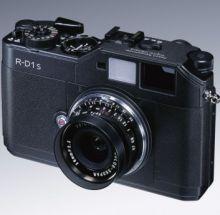Looking for design inspiration? Browse our curated collections!
April 14th, 2011 - 03:37 PM

What's a rangefinder? A rangefinder camera is a camera fitted with a range-finding focusing mechanism allowing the photographer to measure the subject distance and take photographs that are in sharp focus. Most varieties of rangefinder show two images of the same subject, one of which moves when a calibrated wheel is turned; when the two images coincide and fuse into one, the distance can be read off the wheel. Many range finder cameras, such as tose made by Leica, are excellent cameras that produce wonderful results. But is it because of the rangefinder? Usually it is because the rangefinders that are still being produced have excellent optics.
I noticed this rant by Dante Stella and thought others would enjoy it too. I have listed my favorite myths from the post below along with the conclusion. Technogeeks beware, it isn't the camera that creates the image, it is the artist.
— "I find it easier to compose with a rangefinder."
— The problem comes when you are composing using space and selective focus, both critical to portraiture. Using a rangefinder to focus a lens that has a thin plane of focus or tends to exaggerate space is sheer masochism, because a rangefinder presents an aerial image that always shows the same space. Once you hit about 90mm, or f/1.2, whichever comes first, you should be using an SLR, so you can see exactly what's in focus and what's out. When you are using a superwide, you might also use an SLR to see the spatial arrangement of the pieces.
— "Rangefinders focus more accurately."
— This is true, to a point - but to be true, the rangefinder mechanism in the camera has to be aligned perfectly (vertically and horizontally), you have to be able to see clearly, and your lens needs to be 90mm or shorter. Even then, as noted above, you lose focus as a predictable compositional element. SLRs also let you see the depth of field in a lens wide-open, which can be more effective than trying to figure it out using a distance scale on the lens. They also allow you to detect and compensate for bad lenses sometimes because you will see them not focusing. That is not the case with RFs, where you often find out about these problems the hard way.
Then why buy a rangefinder? I think there are a few compelling things about rangefinders, and all but one are related to the subjective qualities of optics.
— Non-retrofocus wide-angle lenses like the 21/3.4 Super Angulon, the 35/2 Summicron and the 21/2.8 Kobalux. There is no question that symmetrical rangefinder lenses outshine retrofocus SLR versions in distortion and resolution. They're also smaller front-to-back. You can get teeny 28s, for example, that make a rangefinder camera pocketable. Retrofocus design (which underlies SLR wideangles) also works better for rangefinder wideangle lenses (as it does in the new Cosina lenses), because with rangefinders it is used to increase the number of lens elements to improve correction rather than being used to radically increase the backfocus distance to clear a 45mm-deep mirror.
— Lenses with well-defined optical fingerprints. These are the 50mm Sonnar-type lenses which could never be made for an SLR due to back-focus constraints. All modern SLR 50mm lenses are planar-type. With a lot of modern lenses you lose bokeh and highlight separation.
— Telephoto lenses no one wants to make anymore. These include Ernostars, Sonnars and Tessars. Again, these have the highlight separation that works well for people's faces.
— Lenses that are tough to get running with a modern body. The first version 105/2.5 Nikkor SLR lens requires an older Nikon F body with no AE, or a disfiguring modification to work with AI meters. By contrast, the 1954 105/2.5 Nikkor rangefinder lens can be put on an autoexposure Hexar RF made in 2001 and used like any modern lens.
Go with your gut. Ultimately, you are the person who chooses your tools. Think carefully. In the end, the experience of the camera makes no difference, nor does its make or model. It is only the image you create with it.
Return to Pete Hellmann Photography
Comments
There are no comments on this blog. Click here to post the first comment.